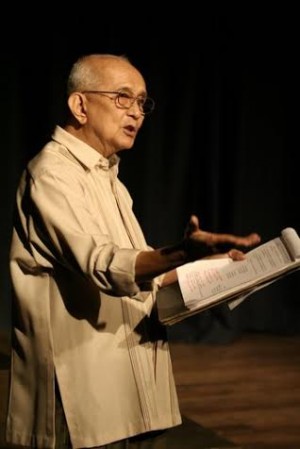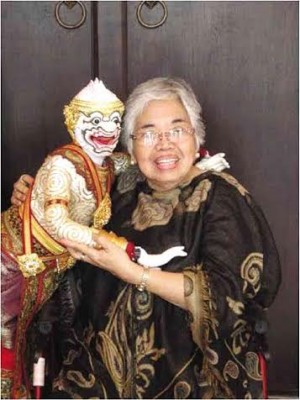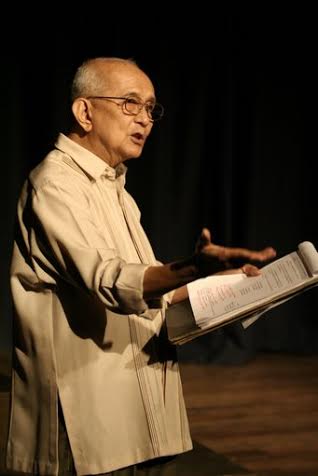
This year, the Philippine Legitimate Stage Artists Guild (Philstage) bestows Lifetime Achievement honors for outstanding contribution to Philippine theater on two theater visionaries: Onofre Pagsanghan and Amelia Lapeña-Bonifacio.
‘Pagsi’
Fondly called “Pagsi” by colleagues and friends, Onofre Rivera Pagsanghan is associated mainly with Ateneo High School’s Dulaang Sibol, the theater company he founded and has run since 1966.
Pagsi was the moderator of Dulaang Sibol’s previous incarnation as the Ateneo High School Dramatics Society from 1956. Believing that theater should be in Filipino and should help in the formation of students, he began experimenting with plays in the vernacular.
In 1967 he initiated Dulaang Sibol’s Paligsahang Pandulaan, a competition for writing and staging one-act plays. Dindo Angeles, then a second year high school student, recalls that the mandate was quite straightforward: Do an original work, in Filipino, produced by students, “without spending a single centavo.”
In that year’s final selection, third year high school student Paul Dumol won with “Ang Paglilitis ni Mang Serapio.” Angeles won second place with Romeo Abrera’s “Kandilang Naagnas,” while fourth year student Nonon Padilla was third place with Tony Perez’s “Hoy Boyet, Tinatawag Ka Na, Hatinggabi Na’y Gising Ka Pa Pala.”
Anton Juan Jr. was also in the Ateneo High School at that time, and as he puts it, Pagsi should be commended for doing “theater in the Philippine language in the institution that was a bastion of English-language instruction.”
Angeles says Pagsi’s end objective was to discover “true, real, Filipino theater talents and their original creative work.” Aside from the yearly output of plays by his students, Pagsi can be credited with leading the return of Philippine theater to Filipino with his translations of plays like Jean Anouilh’s “Antigone,” and adaptations such as Thornton Wilder’s “Our Town,” which became “Doon Po Sa Amin.”
His most famous and most-produced work is “Sinta”—an adaptation of Edmond Rostand’s “Les Romanesques” and Tom Jones’ “The Fantasticks”—for which he wrote the script and the music.
He also coauthored other Dulaang Sibol productions such as the musical “Adarna,” based on the korido, and “Sa Kaharian ng Araw.”
Search for identity
Through these works, Pagsi and Dulaang Sibol indubitably contributed to the “burgeoning national phenomenon of the passionate and frenzied search for national identity,” as Angeles describes it.
Pagsi continuously encouraged his students to write not only plays but also poems and songs. In one of his classes, he wrote the following on the blackboard: “Hindi kita malilimutan…” He then asked the students to add to it.
Someone threw in the line “Hindi kita pababayaan…” Soon enough, more lines were added, enough to come up with a complete poem. One of the students in that class, Manoling Francisco, set the poem into music, and that was how the now-classic song came to be.
But Pagsi’s influence extended beyond the Ateneo campus. Even while he was still a member of the Ateneo High School faculty, he became the artistic director for Drama and Literature at the Folk Arts Theater. He conducted theater workshops for indigent children and out-of-school youth.
A participant in one of these workshops was 11-year-old Soliman Cruz, son of an Air Force serviceman. Recognizing the talent the young boy possessed, Pagsi recommended him for further training and apprenticeship.
Cruz was selected among the first theater scholars of the then newly established Philippine High School for the Arts, and the rest is history. Now with several acting awards and recognition under his belt, Cruz credits Pagsi for his relative success. “What I am today I owe entirely to him,” he says.
88 years old
Pagsi turned 88 yesterday, June 12. He started teaching at the Ateneo High School right after graduation in 1951. He continues to do so today, 25-plus years beyond the nominal retirement age.
Over the years he has received numerous awards and recognitions for his work as a teacher and a leading light of the theater. He still recalls his beginnings: “To me, (Henry Lee) Irwin is not a theater. He is a person: the one who taught me how to speak, how to project.”
He is conscious of his mortality; at a recent advance celebration for his birthday, he prefaced his response by mentioning that going up the stairs leaves him winded, and then apologized that he had to leave right away in order to rest.
But he shows no signs of stopping, and Philippine theater is all the better for it.

‘Tita Amel’
While taking up her Master’s degree in Theater Arts at the State University of Wisconsin (UW) in Madison in the 1950s, Amelia Lapeña-Bonifacio wrote two plays, “Sepang Loca” and “Rooms.”
Both won awards, were staged at UW and anthologized in many publications.
Upon returning to the Philippines, she wrote the full-length play “Walking Canes and Fans” (later translated into “Pagbibinyag sa Apoy at Dugo”) and “The Short, Short Life of Citizen Juan.”
There were three one-act plays: “Tagsibol,” “Tag-Araw” and “Tag-Ani”; and the modern zarzuela “Ang Bundok.”
All these plays have become staples of many theater groups all over the country. Which is not a surprise, because her plays, according to director Tony Mabesa, come out “totally worked out that you don’t need to change anything.”
Next to National Artists Wilfrido Ma. Guerrero and Severino Montano, “she was among those who inspired our generation,” adds Mabesa.
Asian theater, puppetry
Tita Amel, as she is fondly called, also became interested in two things: Asian theater and puppetry. Her interest in Asian traditional theater led to experimenting with various forms using Filipino subjects and themes.
She effectively used Japanese theater conventions in the twin plays “Si Juan at ang Kanyang Madyik na Sombrero: Isang Kyogen sa Pritil” and “Ang Paglalakbay ni Sisa: Isang Noh sa Laguna.”
She has also used the Japanese bunraku, the Indonesian wayang kulit and wayang golek, and the Thai nang yai in her other works.
But it is puppetry that would become her life passion. Impressed by a bunraku performance she witnessed while on a fellowship grant in Japan, she set out to learn more about different puppet theater forms in Asia.
After presenting her first puppet theater production, “Abadeja, Ang Ating Sinderela,” she founded Teatrong Mulat ng Pilipinas. Using materials from Philippine folklore and history, she wrote and directed puppet theater productions such as “Ang Manok at ang Lawin,” “Ang Paghuhukom,” “Ang Pagong at ang Tsonggo,” “Dalawang Bayani” and “Papet Pasyon.”
These plays, along with other productions of Teatrong Mulat, have been toured in and out of the country, especially in festivals focusing on children’s theater and puppetry.
Aside from its tours, Teatrong Mulat now presents productions regularly at its own theater, the Teatro Papet Museo.
Recognitions
Tita Amel has received numerous recognitions for her literary and puppetry work. A teacher at the University of the Philippines since 1959, she was appointed Professor Emeritus after her retirement in 1995.
She continues to oversee the work of Teatrong Mulat ng Pilipinas, though her daughter Amihan Bonifacio Ramolete (recently appointed dean of the UP College of Arts and Letters in Diliman) has been taking a more active role in the company.
The work that Tita Amel and Teatrong Mulat have accomplished has been acknowledged nationally and internationally. It has spawned several children’s theater and puppetry groups, as well as a publishing house for children’s books.
There is no longer any doubt that Philippine theater is alive and well, with audiences eager to sample the variety of offerings all year round from the many groups that now exist.
Whether they know it or not, Filipino theatergoers and practitioners owe a debt of gratitude to these two visionaries whose pioneering efforts have contributed to the robust Philippine theater community we now experience and enjoy.









































